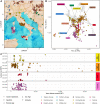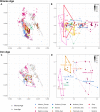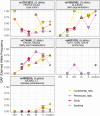Through 40,000 years of human presence in Southern Europe: the Italian case study
- PMID: 34410492
- PMCID: PMC8460580
- DOI: 10.1007/s00439-021-02328-6
Through 40,000 years of human presence in Southern Europe: the Italian case study
Abstract
The Italian Peninsula, a natural pier across the Mediterranean Sea, witnessed intricate population events since the very beginning of the human occupation in Europe. In the last few years, an increasing number of modern and ancient genomes from the area have been published by the international research community. This genomic perspective started unveiling the relevance of Italy to understand the post-Last Glacial Maximum (LGM) re-peopling of Europe, the earlier phase of the Neolithic westward migrations, and its linking role between Eastern and Western Mediterranean areas after the Iron Age. However, many open questions are still waiting for more data to be addressed in full. With this review, we summarize the current knowledge emerging from the available ancient Italian individuals and, by re-analysing them all at once, we try to shed light on the avenues future research in the area should cover. In particular, open questions concern (1) the fate of pre-Villabruna Europeans and to what extent their genomic components were absorbed by the post-LGM hunter-gatherers; (2) the role of Sicily and Sardinia before LGM; (3) to what degree the documented genetic structure within the Early Neolithic settlers can be described as two separate migrations; (4) what are the population events behind the marked presence of an Iranian Neolithic-like component in Bronze Age and Iron Age Italian and Southern European samples.
© 2021. The Author(s).
Conflict of interest statement
The authors declare that they have no competing interests.
Figures





References
-
- Abulafia D (2011) The great sea: a human history of the Mediterranean. Oxford University Press

